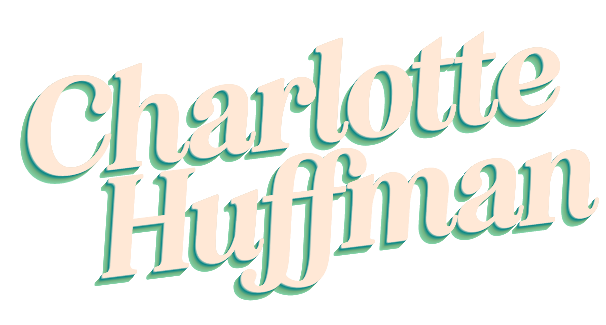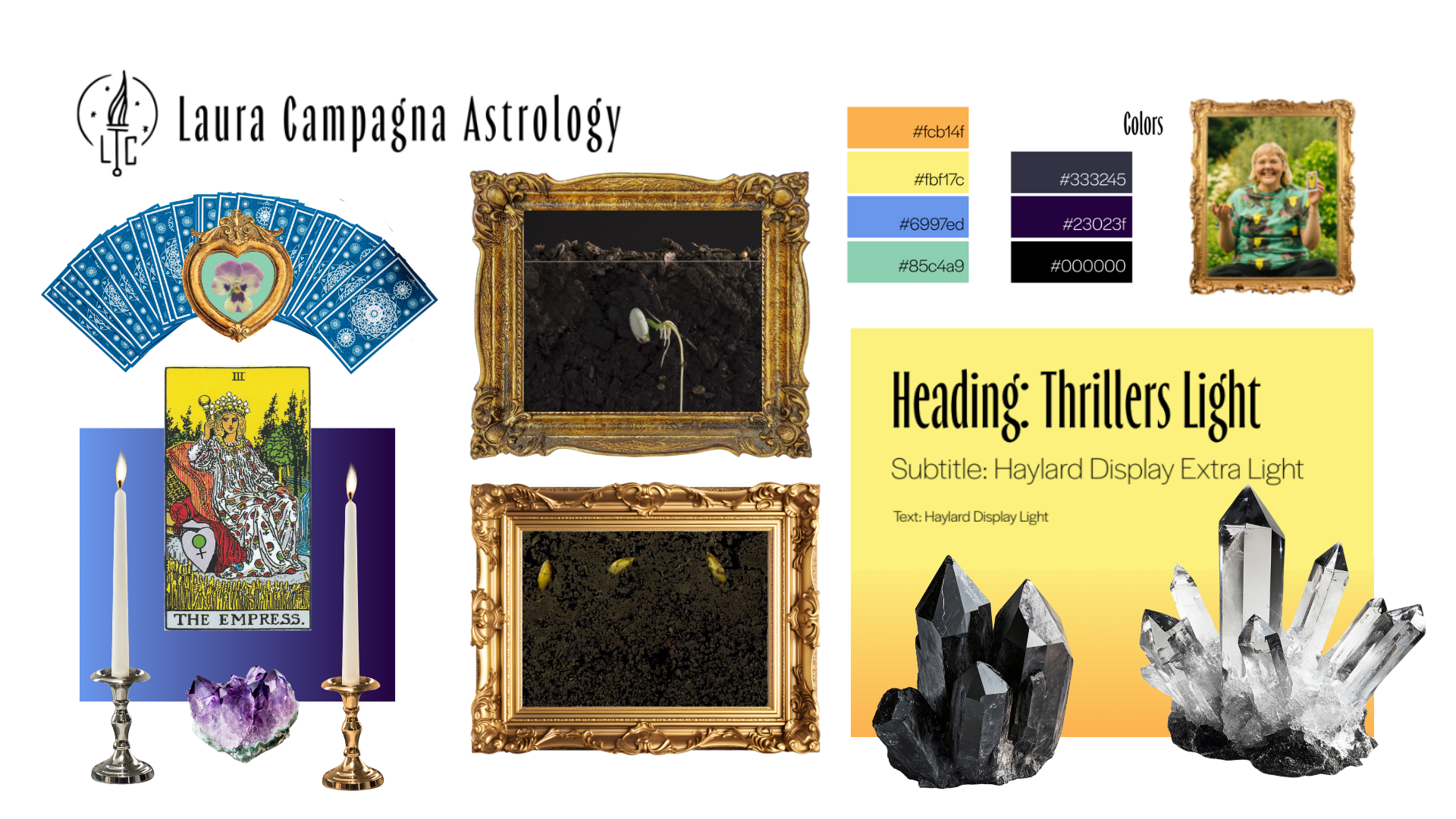
Intuitive Tarot Mini-Course
Exploring eLearning for Small Business Growth
This interactive mini-course introduces learners to a four-card intuitive tarot spread (Past, Present, Challenge, Future). Developed in collaboration with Laura Campagna Astrology for her clients, the project also served as a proof-of-concept to test whether translating her in-person workshops into a self-paced digital format could be a viable business strategy.
Audience:
Learners interested in tarot and self-reflection
Clients of Laura Campagna Astrology (LCA)
Laura herself, as a small business owner exploring eLearning as a scalable offering
My Role:
Instructional Design
eLearning Development
Copywriting
JavaScript Integration
Graphic Design
Business Strategy
Tools:
Articulate Storyline 360
JavaScript
Photoshop & Canva
MindMeister
The Problem
Laura Campagna Astrology offers in-person 8-week intuitive tarot courses that are immersive, reflective, and deeply personal. While these live sessions create strong connections and deep learning, they are limited by time, geography, and the number of participants Laura can reach.
Laura came to me to inquire about what it would look like to transform her 8-week course into online learning modules. Together, we dissected the problem and identified two key questions:
Could her teaching style and content be effectively translated into eLearning while preserving the immersive, reflective quality of her live courses?
Was there an audience willing to pay for the content if offered in a self-paced format?
The Solution
Together, Laura and I began by developing a business strategy: create a free four-card tarot mini-course that would serve both as an introduction to her teaching style and as a way to gauge client demand for a self-paced offering.
We defined a clear benchmark: within 52 days of launch, at least 50 people should complete the free mini-course, and at least 5 of those (10%) should join the asynchronous waitlist — demonstrating sufficient demand to move forward with a full eLearning tarot series.
To support this strategy, I designed a short, branded eLearning module of Laura’s four-card intuitive tarot spread (Past, Present, Challenge, Future).
The module:
Guides learners step by step through the spread with clear, supportive instructions.
Introduces learners to Laura’s style, including a four-minute guided meditation.
Links learners to an online tarot deck they can use throughout the course if they don’t have access to a physical deck.
Delivers randomized reflection prompts (pulled from a bank of ten), so each learner receives a unique prompt with every card, and every reading, keeping the experience dynamic and personal.
Allows learners to record their intentions, reflections, and synopses directly within the course. These entries automatically populate into a custom-branded PDF — designed in Photoshop and powered by JavaScript — which learners can download at the end.
Concludes with clear calls to action: book a reading with Laura, download the PDF of your completed spread, or join the waitlist for the full Intuitive Tarot course.
This solution gives Laura both a working instructional prototype and a market test tool, aligning design decisions directly to her business goals.
The Process
I led the full design process from strategy through development, collaborating with Laura to ensure the module aligned with her teaching style and voice, visual brand, and business goals. The steps below outline how we translated an in-person tarot experience into a scalable eLearning prototype.
Step 1:
Business Strategy
Laura and I began by defining a business test: a free four-card tarot module that would act as both a marketing tool and a way to gauge audience demand for asynchronous eLearning. Together, we set a measurable benchmark: within 52 days of launch, at least 50 people would complete the mini-course, and at least 5 of those (10%) would join the waitlist for the asynchronous course.
Why 5? Because a 10% conversion rate is a strong early signal of market demand. Even a small group of committed learners demonstrates product–market fit and shows potential for scale. For example, if 5 out of 50 participants sign up, that ratio could project to 50 out of 500, or 100 out of 1,000, creating meaningful revenue opportunities for Laura’s business. This low-bar benchmark reduced risk while giving Laura a clear way to decide whether to invest in a full eLearning build.
Step 2:
Text-Based Storyboard
I created a text-based storyboard in close collaboration with Laura to ensure her instructional style and tone were woven into the copy. The storyboard mapped the learner journey — from setting an intention, to pulling each card, to responding to randomized reflection prompts, and finally downloading the personalized PDF.
This early, low-fidelity prototype also kept Laura and me aligned on expectations. By reviewing the storyboard together, we ensured we had a shared understanding of the product before moving into design and development, which streamlined later feedback and reduced the need for major revisions.
Step 3:
Wireframes, Moodboard & Prototyping
I translated the storyboard into low-fidelity wireframes to clarify structure and layout, then created a moodboard to establish the visual direction. Together, Laura and I chose a collage aesthetic, a design approach that allowed us to weave mystical and natural elements (tarot cards, candles, and organic imagery) into the course in a beautiful, layered way.
Laura and I reviewed an extensive gallery of images together, where she gave quick “yes/no” feedback. This process ensured all the collage elements reflected her style and values while staying aligned with her brand identity.
From there, I built a prototype in Articulate Storyline. We refined this single evolving prototype through multiple feedback sessions, adjusting the tone of the copy, the pacing of card pulls, and the flow of reflection prompts. This iterative process kept Laura closely involved and ensured the final product felt authentic, polished, and true to both her instructional style and brand.
Visual Design and Branding
I carried the collage aesthetic we selected in Step 3 into the final course visuals. Using Photoshop and Canva, I created assets that layered tarot cards, candles, and natural imagery in a way that felt both mystical and grounded. This collage approach allowed me to weave Laura’s brand identity into every screen while maintaining accessibility and readability.
I also applied this visual method to the branded PDF download that learners can opt to receive at the end of the course. The PDF, which auto-populated with each learner’s intention, reflections, and synopsis, echoed the same collage design — creating a consistent, beautiful takeaway that extended the learning experience beyond the course itself.
Throughout this stage, I focused on balance: ensuring the design was visually rich enough to reflect the depth of tarot, while still clean and intuitive for learners moving through the course. The final visual style felt authentic to Laura Campagna Astrology, blending beauty with usability.
Technical Development
I built the final module in Articulate Storyline 360, bringing together the instructional flow, branded visuals, and interactive elements. To extend Storyline’s core functionality, I integrated custom JavaScript that allowed learners’ intentions, reflections, and synopses to be recorded throughout the course and automatically populate into the branded PDF.
This technical solution gave learners a seamless experience: their responses were captured as they progressed, and by the end of the course they could download a personalized, beautifully designed PDF to keep as a takeaway. The integration of Storyline with custom code ensured the module was not only interactive, but also produced a meaningful artifact that reinforced both reflection and Laura’s brand.
Step 6:
Business Integration
The course concludes with three clear, calls to action that connected the learning experience directly to Laura’s business goals:
Book a session with Laura for more personalized guidance
Download the branded PDF as a record of the learner’s reflections and spread
Join the waitlist for the full Intuitive Tarot eLearning course
These actions were intentionally chosen to serve dual purposes: they offer learners meaningful next steps after completing the module, and they provide Laura with valuable business insights. The PDF reinforces her brand and gives learners a tangible takeaway, while the waitlist sign-ups create a measurable signal of market demand — the very benchmark we set at the beginning of the project.
By embedding these calls to action, the module functions not only as an engaging learning experience but will also serve as a business strategy tool, validating whether there is enough interest in self-paced tarot learning to justify investing in a full course series.
Business Goal:
By 52 days after launch, at least 50 people will complete the free four-card intuitive tarot module, and at least 5 of those (10%) will sign up for the asynchronous eLearning waitlist.
Meeting this benchmark will demonstrate sufficient market demand for Laura Campagna Astrology to proceed with developing the full eLearning tarot series.
Step 4:
Step 5:
Takeaways
This project demonstrates how instructional design can translate an intuitive, in-person learning experience into a structured, engaging eLearning module — while also supporting a client’s business strategy.
Instructional Design: I transformed an abstract, reflective practice (intuitive tarot reading) into a clear learner journey with step-by-step instructions, randomized prompts, and structured reflection moments.
Collaboration & Brand Alignment: Through moodboards, prototyping, and feedback sessions, I worked closely with Laura to ensure her instructional style and visual identity were carried through to the final product.
Technical Innovation: By integrating custom JavaScript with Articulate Storyline, I enabled learners to capture their reflections in real time and generate a personalized, branded PDF takeaway.
Business Strategy Integration: The module doubled as a market test, with measurable goals (50 completions and 5 waitlist sign-ups) that will provide Laura with clear data on whether to invest in a full course series.
Together, these elements showcase my ability to create eLearning that is not only instructionally sound and visually compelling but also strategically aligned with business goals.













